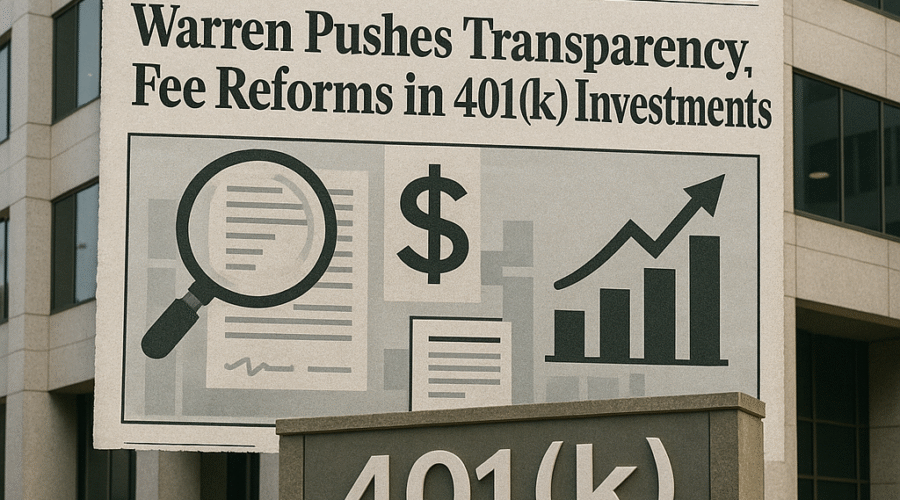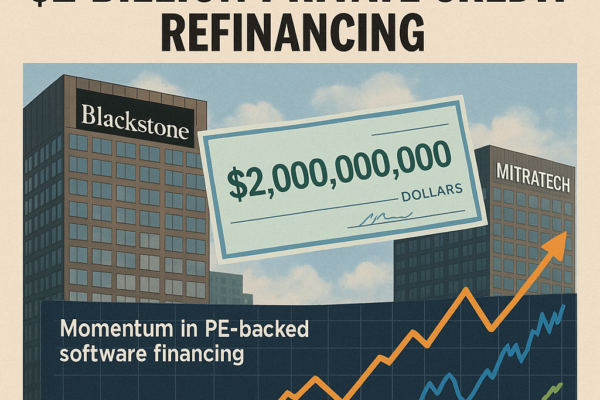Senator Elizabeth Warren’s opposition to integrating private equity into 401(k) plans has ignited a high-stakes debate over retirement security, pitting Wall Street’s pursuit of $9 trillion in retirement assets against fiduciary safeguards. Empower Retirement’s May 2025 announcement allowing 19 million participants access to private markets via collective investment trusts (CITs) marks a watershed moment in this conflict, with Warren challenging the move over opaque fee structures, liquidity risks, and misaligned incentives. This confrontation unfolds against a backdrop of regulatory uncertainty, including a recent 5th Circuit Court ruling striking down SEC transparency rules for private funds and draft executive orders from the Trump administration that could accelerate private equity’s retirement market expansion. The outcome will determine whether ordinary savers gain “democratized” access to alternative assets or inherit systemic vulnerabilities that could jeopardize retirement stability.
💼 Seasoned CorpDev / M&A / PE expertise
The Clash: Empower’s Initiative vs. Regulatory Scrutiny
Empower’s Market Disruption
Empower’s partnership with Apollo, Goldman Sachs, and other private equity giants represents the largest-scale effort to date to embed alternative assets in defined contribution plans. The structure uses CITs to pool investments across private equity, credit, and real estate, capping allocations at 10% of a participant’s portfolio with projected fees of 1-1.6%. Crucially, access requires employer adoption through managed accounts, positioning advisors as gatekeepers who must align investments with individual risk profiles. CEO Ed Murphy frames this as “democratization,” noting that 87% of U.S. companies with $100M+ revenue are privately held, thus inaccessible to 401(k) investors historically[3][14][16].
Warren’s Counterarguments
In a June 2025 letter to Empower’s CEO, Senator Warren demanded justification for introducing “high-risk, high-fee” products into retirement accounts, citing three core concerns: First, the “2 and 20” fee model (2% management fee plus 20% performance fee) common in private equity could erode returns, particularly for small-balance savers. Second, limited transparency in asset valuation and fee disclosure violates ERISA’s fiduciary standards. Third, private credit markets show signs of overheating, with covenant-lite loans comprising 85% of issuance—a vulnerability for retirement portfolios during economic downturns[1][17].
Structural Vulnerabilities in Private Equity Integration
Fee Stacking and Performance Realities
Private equity’s layered fee structure creates compounding costs: Beyond the “2 and 20” charged by general partners, funds-of-funds add another 1% management fee, while CITs impose administrative expenses. Analysis of pension fund performance reveals these fees rarely justify themselves; Oregon’s Public Employees Retirement Fund saw private equity underperform its benchmark by 32 percentage points in 2024 despite paying 1.5-2% in management fees. For 401(k) participants, whose median account balance is $30,000, even a 1% fee difference could reduce lifetime wealth by 28% according to DOL estimates[11][17].
Liquidity Mismatches
Private equity’s 10-year lockup periods fundamentally conflict with 401(k)s’ daily liquidity requirements. Empower’s CIT structure attempts mitigation through “liquidity sleeves,” but industry data reveals alarming illiquidity: 61% of buyout-backed assets have been held over four years, with average holding periods stretching to 6.7 years. Secondary market discounts have widened to 11% in 2024 as exit bottlenecks worsen, suggesting participants could face redemption restrictions during market stress[7][17].
Valuation Opacity
Unlike publicly traded securities, private assets lack standardized valuation methodologies. A 2024 Preqin study found 40% divergence in appraisals of identical assets by different auditors. This ambiguity creates fiduciary peril: Plan sponsors must certify prudent investment selection under ERISA, yet DOL guidance explicitly warns that small-plan fiduciaries “lack resources to adequately assess private equity valuations”[4][5][9].
Regulatory Fault Lines
The DOL’s Evolving Stance
The Department of Labor’s 2020 Information Letter initially greenlit private equity in CITs, but its December 2021 clarification imposed critical constraints: Small-plan fiduciaries were deemed “unlikely suited” to evaluate such investments, while large plans must conduct quarterly due diligence on valuation methodologies and fee audits. This regulatory schizophrenia continues under the current administration, with DOL Secretary nominee Lori Chavez-DeRemer reportedly negotiating safe harbor provisions for early adopters like Empower[4][9][14].
Legislative Countermeasures
Senator Warren’s Stop Wall Street Looting Act—reintroduced in October 2025—proposes sweeping reforms: It would impose joint liability on private equity firms for portfolio company debts, ban dividends for two years post-acquisition, and tax carried interest as ordinary income. Most critically for retirement plans, Section 205 mandates fee transparency requiring itemized disclosure of all direct/indirect compensation, with penalties up to 100% of undisclosed fees[2][8].
Judicial Setbacks
The July 2024 5th Circuit Court ruling striking down SEC private fund transparency rules dealt a blow to accountability. By invalidating requirements for quarterly performance reporting and equal investor treatment, the decision eliminated key safeguards just as private equity entered 401(k)s. Industry lobbyists hailed it as a victory against “burdensome regulation,” while investor advocates warned it enables “extraction of wealth from ordinary savers”[10].
Fiduciary Implications for Plan Sponsors
Litigation Exposure
Sponsors offering private equity options face unprecedented liability vectors. ERISA’s prudence rule requires continuous monitoring of investment performance and fees, yet private assets’ quarterly reporting (vs. daily for public securities) creates compliance gaps. Historical precedent suggests vulnerability: In 2023, Lockheed Martin settled a $62M lawsuit over allegedly excessive recordkeeping fees—a simpler case than proving prudent selection of opaque private assets[4][17].
Managed Account Dilemma
Empower’s requirement that private allocations flow through advisor-managed accounts shifts—but doesn’t eliminate—fiduciary risk. Advisors must now document risk-tolerance alignment for each participant, a process complicated by private equity’s benchmark ambiguity. The American Retirement Association warns this creates “impossible choices” between overly conservative allocations that negate return advantages and aggressive stances that court suitability lawsuits[15][16].
Market Forces Driving the Push
Private Equity’s Capital Crunch
With exit volumes down 38% in 2024 and fundraising slumping, private equity desperately needs new capital sources. Retirement plans’ $9.1 trillion in assets represent a tantalizing solution—shifting just 5% to alternatives would inject $455 billion. Apollo CEO Marc Rowan openly described 401(k)s as “the industry’s next frontier” at a May 2025 conference, noting traditional institutional investors are “overallocated” to alternatives[7][12].
Political Catalysts
Draft executive orders from the Trump administration would direct the DOL, Treasury, and SEC to “remove barriers” to private equity in retirement accounts. This aligns with 2025 House Republican proposals to relax the “prudent investor rule” for alternatives. Empower’s Murphy confirmed lobbying for “fiduciary litigation reform,” seeking safe harbors akin to those for target-date funds[12][14].
Performance Realities vs. Promised Returns
The Illusion of Outperformance
Industry claims of private equity’s superior returns face mounting skepticism. Cambridge Associates data shows U.S. buyout funds underperformed the S&P 500 in 7 of the past 10 years after fees. The “denominator effect” further distorts perceptions: When public markets fall, private assets’ stale valuations artificially inflate portfolio performance—a statistical illusion that could mislead plan sponsors[17].
Concentration Dangers
Top-quartile performance masks extreme concentration: Just 5% of private equity firms generate 80% of industry profits according to McKinsey. For 401(k) participants, this creates a “lottery ticket” effect where most receive mediocre returns while paying premium fees. Bain & Company calculates that median net IRR for 2015-vintage funds was 12.3%—only 1.8% above public equities after liquidity discounts[11][17].
Resolution Pathways
Structural Safeguards
Three innovations could mitigate risks: First, blockchain-based valuation ledgers would create auditable asset pricing trails. Second, “fee waterfalls” tying manager compensation to net-of-benchmark returns would align interests. Third, liquidity buffers funded by fee reserves could cover redemption surges. BlackRock is piloting such a structure with the Texas Teachers fund, though scalability for small plans remains unproven[5][15].
Regulatory Compromises
A potential middle ground emerges from the DOL’s 2021 guidance: Limiting private allocations to large plans with independent fiduciaries, mandating third-party audits, and capping fees at 0.75% for CITs. Warren’s bill could be modified to exempt CITs meeting these standards while preserving core transparency mandates[4][9].
Conclusion: The Retirement System at a Crossroads
The integration of private equity into 401(k) plans represents a fundamental reordering of retirement risk dynamics. While proponents correctly note the diversification benefits of alternative assets, current structures insufficiently address the trifect
Sources
https://www.benzinga.com/personal-finance/management/25/06/46013443/elizabeth-warren-challenges-plan-to-bring-private-equity-into-401ks-citing-transparency-and-fee-concerns, https://www.warren.senate.gov/newsroom/press-releases/icymi-warren-calls-for-reforms-to-clean-up-the-private-equity-industry-and-put-workers-and-communities-first, https://www.napa-net.org/news/2025/5/empower-to-offer-private-investments-in-401ks-ceo-ed-murphy-explains-why/, https://www.asppa-net.org/news/2021/12/dol-clarifies-guidance-private-equity-401k-plans/, https://www.marinerwealthadvisors.com/wp-content/uploads/2020/07/DOL-Approves-Use-of-Private-Equity-in-401k-Plans-1.pdf, https://www.warren.senate.gov/oversight/letters/warren-to-private-equity-industry-lobbyists-dont-exploit-the-covid-19-pandemic-to-line-the-pockets-of-the-wealthy-at-the-expense-of-struggling-workers-and-communities, https://www.youtube.com/watch?v=tiBJPm_bIw0, https://www.fredlaw.com/the-restructuring-report/warren-targets-private-equity, https://www.willkie.com/publications/2021/12/dol, https://www.questce.com/u-s-court-strikes-down-sec-rule-on-private-fund-transparency/, https://www.moonfare.com/blog/private-equity-fees, https://www.benzinga.com/news/25/05/45536753/trump-eyes-retirement-overhaul-that-could-push-billions-from-401ks-into-high-stakes-private-equity-funds-report, https://www.educationaldatamining.org/EDM2016/proceedings/edm2016_postersdemos.pdf, https://www.psca.org/news/psca-news/2025/5/empower-will-offer-private-assets-in-401k-plans/, https://www.planadviser.com/empower-401ks-will-get-access-private-investments/, https://401kspecialistmag.com/empower-offering-private-investments-in-dc-plans/, https://www.ainvest.com/news/private-equity-401-risky-gamble-retirement-savings-2506/





